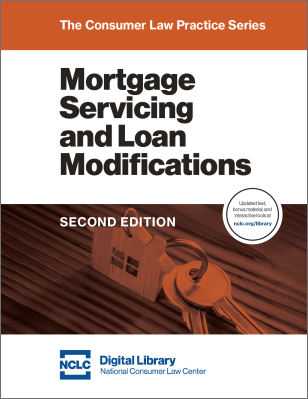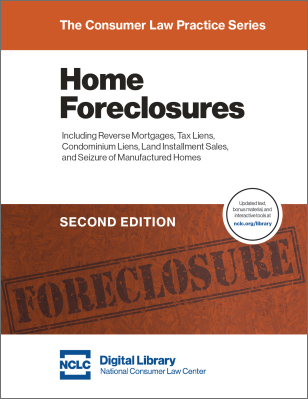In the wake of recent natural disasters, two detailed new sections covering homeowner rights and risks following a natural disaster have been added to NCLC’s Mortgage Servicing and Loan Modifications Chapter 12. For a limited time, no subscription is required for access to Chapter 12 (also including a third section on special COVID rights). This article summarizes twelve tips for homeowners working to recover from a natural disaster, with links for more information to those two new Chapter 12 sections, that for a limited time are free and accessible for all readers.
Tip One: Identify Sources of Assistance
A natural disaster can require a wide array of services for affected individuals—not only food and shelter, but also mental health and legal:
- In many states, dialing “211” shortcuts one through a bewildering maze of health and human service agency phone numbers, allowing immediate referral or even connection to appropriate agencies and community organizations. 211 covers all fifty states, the District of Columbia, and Puerto Rico. To find out whether 211 services are offered in your area and to obtain more information, visit 211.org.
- Local Voluntary Organizations Active in Disaster (VOAD) can be identified at https://www.nvoad.org/state-territory-voad/.
- To find a FEMA Crisis Counseling Program, call the FEMA Helpline 1-800-621-FEMA (3362) or, for the hearing impaired, 1-800-462-7585.
- Disaster Legal Services (DLS) may become available where the American Bar Association Young Lawyers Division in tandem with FEMA work together to provide and coordinate legal services in the affected area.
- The ABA maintains a webpage for disaster legal assistance resources.
- The Legal Services Corporation (LSC) Disaster Task Force maintains a helpful webpage with resources.
- NCLC has a Disaster Relief & Consumer Protection web page with links to resources and information concerning housing & mortgages, bankruptcy, credit reports, student loans, debt, utilities, autos, older consumers, and insurance.
For more information, see NCLC’s Mortgage Servicing and Loan Modifications § 12.1.4.3. NCLC has also created a detailed flow chart for disaster relief.
Tip Two: Apply for FEMA Assistance When There Is a Presidential Disaster Declaration
When there is a Presidential disaster declaration, FEMA provides various forms of assistance: direct financial aid for repairs or displacement housing costs, temporary housing units like FEMA trailers, money for necessary expenses like replacement of personal property, childcare, medical and dental costs, funeral expenses, and other items. The Presidential disaster declaration specifies the scope of available assistance for a disaster and can be referenced to ascertain what types of assistance are available. See 44 C.F.R. § 206.110; NCLC’s Mortgage Servicing and Loan Modifications § 12.1.4.1.2.
Apply as soon as possible by either calling 800-621-FEMA (6632) (TTY: 800-462-7585) or submitting an online application at DisasterAssistance.gov. FEMA may set up Disaster Recovery Centers where people can apply in-person. It is important to apply, even if a person does not need immediate assistance. A FEMA application number is invaluable for applying for various forms of assistance in the future. See NCLC’s Mortgage Servicing and Loan Modifications § 12.1.4.1.3.
On September 2, 2021, FEMA amended its Individual Assistance Program and Policy Guide to loosen documentation requirements to verify home ownership and also home occupancy. This should be helpful for those with land installment contracts/contracts for deeds, where probate has not been done on an intestate estate, and other situations where home ownership is difficult to document.
One can create an online account on http://www.disasterassistance.gov to view all documents that FEMA sends to the individual, but it may include only the titles of documents that FEMA received from the individual. Also usually not included in an online account are FEMA inspection reports, photos, FEMA’s internal notes about your file, conversation notes, or other information. The full file can be obtained by mailing a request to FEMA - Individuals & Households Program, National Processing Service Center, P.O. Box 10055, Hyattsville, MD 20782-8055. Include the FEMA application number, identification of the disaster, Social Security number, and a current mailing address, among other information. For a sample letter, see NCLC’s Mortgage Servicing and Loan Modifications Appx. E.3.8.
Denial of an application for FEMA assistance can be appealed if within sixty days of an ineligibility determination, and appeals can be submitted by mail, fax, online at http://www.disasterassistance.gov, or in-person at a disaster relief center. See NCLC’s Mortgage Servicing and Loan Modifications § 12.1.4.1.5. Those receiving cash assistance may have to recertify eligibility for ongoing support, submitting receipts once every three months documenting disaster-related housing costs and a lack of adequate alternate housing, among other possible required proofs. Failure to recertify can lead to loss of ongoing assistance.
Tip Three: Receive Payments Under Homeowners and Flood Insurance
Almost all insurance claims involve an inspector or appraiser visiting the property and preparing an inspection report. If the insurance company approves the claim and the homeowner has a mortgage, the funds likely will issue to the insured and their mortgage company—the homeowner will need to sign the check and send it to the mortgage servicer. How the servicer will release insurance payments for repairs vary by the mortgage investor and is described at Step Eight, infra.
If the disaster involves multiple forms of damage, sometimes the homeowners insurance company will claim coverage should be provided only under a separate flood insurance policy and the flood insurer will insist on coverage under the homeowner policy. Other issues involve whether coverage is under an individual’s condominium policy or the master policy for the condominium. Other disputes may revolve around policy exclusions and limits and the appraisal itself. Flood insurance has strict time limits for submitting claims, and generally will not cover all the homeowner’s damage.
Public adjusters work with insureds to help increase their claim award in exchange for a percentage of the recovered claim amount. Although there are reputable and ethical public adjusters, beware of storm-chasing scammers (often operating without a required license) looking for vulnerable people whose insurance funds they can siphon off.
For more on insurance issues, see NCLC’s Mortgage Servicing and Loan Modifications § 12.1.4.2.
Tip Four: Avoid Pitfalls When Dealing with Home Repair Contractors
Even reputable home repair contractors will often be slow in performing because of the large amount of other work they take on after a disaster and shortages in building materials. But be particularly wary of storm chasers that show up after a disaster and go door-to-door, create flyers, or otherwise aggressively market their services, often with professional-looking business websites or Facebook pages with phony customer reviews. These scammers obtain payments in advance, do little or no work, perhaps ask for additional payments, and disappear. Check that contractors are properly licensed but be aware that sophisticated storm chasers will often obtain proper licensing. At risk is not only insurance proceeds or other payments, but non-payment to either reputable or even scam operators may result in a lien being placed on the home. For more on these issues, see NCLC’s Mortgage Servicing and Loan Modifications § 12.1.4.3.
Tip Five: Be Aware of Municipal Code Issues
Municipal code inspections may be a problem when the municipal code office is unavailable due to the disaster, when shoddy contractor work prevents issuance of a required inspection certificate for repairs to continue, or when a certificate of occupancy is needed for the homeowner to move back into the property. If a house had work done by a previous contractor that was not code compliant or the house is so old that it never complied with code, the costs and work required to make the home code-compliant may be extensive. In dealing with a contractor, the homeowner should also be sure that the written contract specifies who is responsible to pay for code inspection costs.
Municipal codes may also require elevation work to avoid future flooding. Those with coverage under the National Flood Insurance Program can obtain up to $30,000 for elevation or other hazard mitigation repairs if they submit a substantial damage determination letter from their municipality’s floodplain manager. There is a risk that the floodplain manager will require work costing more than the $30,000, but the manager’s determination can be appealed.
A homeowner needing repairs that violate municipal zoning regulations must apply for a zoning variance. Variance applications often require notice and a hearing before the municipal governing body; other residents may object to the variance. Ultimately, the variance application may be denied, and then the homeowner may encounter further costs for changing the scope of repair work.
For more on municipal code issues, see NCLC’s Mortgage Servicing and Loan Modifications § 12.1.4.4.
Tip Six: Apply for Available Local and State Grants
After a natural disaster, federal funds may flow to state and local governments to set up grant programs for affected consumers, including housing repair programs, rental assistance programs, personal property and appliance replacement funds, and other services. Watch out for continually updated and sometimes confusing guidelines for grant applications. Appeals of grant denials are possible. There is also a risk that grants improperly awarded can result in civil actions to recover the improper amount or even criminal actions. For more on these issues, see NCLC’s Mortgage Servicing and Loan Modifications § 12.1.4.5.
Tip Seven: Determine the Mortgage Loan Investor—An Essential Step in Dealing with Mortgage Payments and Insurance Proceeds
Homeowners affected by a natural disaster may have difficulty keeping up mortgage payments, and typically will need the mortgage owner’s permission for release of any insurance payments. Homeowner rights concerning these issues vary depending on the mortgage loan’s investor. Most loans are federally backed, and in general it is these loans that offer homeowners explicit rights in a natural disaster. It is important to identify which of these five investors is involved with a mortgage loan:
- Fannie Mae loans are identified using the Fannie Mae look-up tool.
- Freddie Mac loans are identified using the Freddie Mac look-up tool.
- Federal Housing Agency (FHA) insurance for a mortgage loan is usually identified on loan documents, mortgage statements, or closing documents.
- Department of Veterans Affairs (VA) guaranty for a mortgage loan is usually clear from the text of the mortgage and note.
- U.S. Department of Agriculture, Rural Housing Service (USDA) clearly identifies itself as the lender for USDA Direct Loans, and the USDA services these loans through its national servicer.
- USDA Guaranteed Loans are more difficult to identify, as there generally is no specific loan language. Review the HUD-1 Settlement Statement and attachments to the note.
Another approach is to send the mortgage loan servicer a Request for Information (RFI) under RESPA asking for the investor’s identity. See NCLC’s Mortgage Servicing and Loan Modifications §§ 3.3.3, 3.8.2.10.
Loans involving other investors typically will not have clear and publicly available rules for loan modifications and disaster relief. Contact the servicer and ask for help, and where loan servicers are not helpful, consider escalating the case within the loan servicer and also contact elected officials.
The USDA has a special website dealing with disaster assistance which is helpful in dealing with a USDA Direct Loan or USDA Guaranteed Loan.
Tip Eight: Seek Release of Insurance Proceeds and Issues with New Insurance
Mortgage loans typically require the homeowner to obtain homeowners and possibly flood insurance, and any insurance payments following a natural disaster will be made out to both the homeowner and the mortgagee. Rules differ as to the conditions where a mortgagee will release the mortgage payments to the homeowner. This will be an obvious concern affecting how quickly the homeowner can pay contractors and others for needed repairs.
If a home is destroyed or must involve a major construction, a new mortgage is often necessary, but required insurance for the new mortgage may be unaffordable or unavailable. As described below, FHA provides an important option in this situation.
- For Fannie Mae, if the homeowner was current or almost current on the mortgage prior to the disaster, disbursement is made in one payment for amounts up to $40,000, and at least a third of the proceeds (depending on a formula) in an initial payment for higher insurance proceed amounts. For delinquent borrowers, the amount released initially is significantly less. See NCLC’s Mortgage Servicing and Loan Modifications § 12.2.2.8.
- Freddie Mac procedures are like those for Fannie Mae. See NCLC’s Mortgage Servicing and Loan Modifications § 12.2.3.8.
- For FHA mortgages, with certain eligibility requirements, FHA insures new mortgages for victims of a disaster for the purchase or reconstruction of a single-family property. This program allows FHA-approved lenders to provide financing for homeowners (or renters) whose residences were destroyed or damaged to such an extent that reconstruction or replacement is necessary, and it provides 100% financing for the purchase or reconstruction of a home. See NCLC’s Mortgage Servicing and Loan Modifications § 12.2.4.6.
- For VA mortgages, the regulations simply provide that insurance proceeds shall be applied to restoration of the security or to the loan balance. See NCLC’s Mortgage Servicing and Loan Modifications § 12.2.5.5.
- For USDA Direct Loans, where homeowners current on their mortgage, up to $10,000 can be released with minimal paperwork, but for larger amounts additional review is required. Repairs will be inspected and amounts not used for repairs must be used to reduce the loan amount. See NCLC’s Mortgage Servicing and Loan Modifications § 12.2.6.3.
- For USDA Guaranteed Loans, proceeds are released in draws with periodic inspections or applied to the loan balance if repairs are not to be made. See NCLC’s Mortgage Servicing and Loan Modifications § 12.2.7.6.
Tip Nine: Determine Any Applicable Foreclosure Moratorium and Eviction Suspension
Knowing that foreclosure or eviction is not imminent can take a lot of pressure off the homeowner. All five federally related investors have policies on foreclosure moratoriums or eviction suspensions following a natural disaster, but policies differ:
- Fannie Mae suggests a foreclosure suspension when the servicer “has any doubt about the effect of the disaster event on the condition of a property or the borrower's employment or income status,” as described at NCLC’s Mortgage Servicing and Loan Modifications § 12.2.2.2.
- As with Fannie Mae, Freddie Mac may require servicers to suspend foreclosure sales and evictions for a prescribed period. NCLC’s Mortgage Servicing and Loan Modifications § 12.2.3.2.
- FHA provides that homes in presidentially declared major disaster areas are subject to a ninety-day moratorium on foreclosures following the disaster. See NCLC’s Mortgage Servicing and Loan Modifications12.2.4.2.
- VA indicates that the loan servicer determines when to initiate foreclosure, but the VA requests that servicers establish a ninety-day moratorium from the date of a disaster, and under certain circumstances, the VA may require servicers to suspend foreclosure sales and evictions for a prescribed time. See NCLC’s Mortgage Servicing and Loan Modifications § 12.2.5.2.
- USDA Direct Loans offer payment options but no explicit foreclosure moratorium. See NCLC’s Mortgage Servicing and Loan Modifications § 12.2.6.
- USDA requires servicers of its guaranteed loans to suspend, for directly affected homes, all foreclosure-related actions for ninety days from the date of declaration unless extended by the agency. See NCLC’s Mortgage Servicing and Loan Modifications § 12.2.7.2.
Tip Ten: Consider Loan Payment Forbearance
A mortgage loan forbearance permits the homeowner to delay making payments for a time without creating a default. Late charges may be waived, and in some cases negative credit reports avoided. But interest will continue to accrue during the forbearance period and the remaining principal balance is not reduced. The full principal and interest will eventually have to be repaid. Nevertheless, after a disaster, loan forbearance may be essential:
- Fannie Mae provides that servicers in contact with the borrower during the disaster relief period may offer for most mortgage loans an initial forbearance plan term of up to six months, with an additional six months being available, and further extensions are even possible. If the servicer is not in contact with the borrower, the forbearance is limited to three months. See NCLC’s Mortgage Servicing and Loan Modifications § 12.2.2.4. Late charges are suspended. See NCLC’s Mortgage Servicing and Loan Modifications § 12.2.2.3.
- Freddie Mac provides, for certain mortgages, forbearance up to twelve months (that can be extended in certain circumstances) if the servicer is in contact with the homeowner. If the servicer is not in contact with the homeowner, forbearance is generally limited to ninety days. See NCLC’s Mortgage Servicing and Loan Modifications § 12.2.3.4. Late charges are suspended. See NCLC’s Mortgage Servicing and Loan Modifications § 12.2.3.3.
- FHA provides for forbearance where a presidentially declared emergency impacts the borrower’s ability to pay. See NCLC’s Mortgage Servicing and Loan Modifications § 12.2.4.3. Servicers must waive late fees and the mortgagee must suspend reporting of delinquencies to consumer reporting agencies where the homeowner is performing as agreed. See NCLC’s Mortgage Servicing and Loan Modifications § 12.2.4.3.
- The VA encourages servicers of loans in disaster areas to extend all possible forbearance to borrowers in distress. See NCLC’s Mortgage Servicing and Loan Modifications § 12.2.5.3. The VA urges suspension of credit reporting and encourages waiver of late fees for loans in disaster areas. See NCLC’s Mortgage Servicing and Loan Modifications § 12.2.5.3.
- USDA Direct Loan borrowers who face loss of income or increased expenses that impair their ability to make regularly scheduled payments may be eligible for forbearance for 180 days, with a possible extension for another eighteen months. See NCLC’s Mortgage Servicing and Loan Modifications § 12.2.6.2.
- For USDA Guaranteed Loans, forbearance is encouraged, but not required for up to twelve months. SeeNCLC’s Mortgage Servicing and Loan Modifications § 12.2.7.4. Credit reporting and late charges are suspended. See NCLC’s Mortgage Servicing and Loan Modifications § 12.2.7.3.
Tip Eleven: Apply for Loss Mitigation After Forbearance
A forbearance is not a permanent solution to the homeowner’s repayment problems, but just puts them off to a time when hopefully the old level of mortgage payments become affordable. But the homeowner is also liable for the skipped payments and additional accrued interest. Just as essential as a homeowner’s forbearance rights immediately following a disaster are the homeowner’s options when exiting a forbearance:
- Fannie Mae requires servicers to attempt to contact the homeowner at least thirty days prior to the forbearance expiration and offer the most appropriate repayment plan. See NCLC’s Mortgage Servicing and Loan Modifications § 12.2.2.5. A Disaster Payment Deferral is appropriate for those who can resume the payment at the level in effect prior to the disaster, with the amounts that were forborne put off until the end of the mortgage term, accruing at zero percent interest. See NCLC’s Mortgage Servicing and Loan Modifications § 12.2.2.6. A Flex Modification is an option for those who cannot afford the prior payment amounts. Flex Modifications offer eligible borrowers a lower payment through a combination of a lower interest rate, longer payment term, forbearance of part of principal. No principal is cancelled. See NCLC’s Mortgage Servicing and Loan Modifications §§ 7.3.1, 12.2.2.7. Short sales and deed in lieu options are also available.
- Freddie Mac options are like those under Fannie Mae. See NCLC’s Mortgage Servicing and Loan Modifications §§ 12.2.3.5, 12.2.3.6, 12.2.3.7.
- FHA requires mortgagees to offer a Disaster Loan Modification, where the principal and interest payment does not change from its pre-disaster level, and late fees are waived. The lender capitalizes the past-due amounts to bring the loan current, sets the interest rate to the HUD-defined market rate, and extends the term up to 360 months. Another option is the Disaster Standalone Partial Claim where the forborne amount is put off until the end of the term at zero percent interest. See NCLC’s Mortgage Servicing and Loan Modifications § 12.2.4.4. FHA-HAMP, as described at NCLC’s Mortgage Servicing and Loan Modifications § 8.2.3, is yet another option for eligible homeowners, as is a pre-foreclosure sale or deed in lieu of foreclosure.
- VA offers two options. The Disaster Loan Modification allows for a loan modification at a fixed-interest rate not to exceed fifty basis points over the current Freddie Mac rate for fixed thirty-year mortgages. The VA Disaster Extend Modification extends the maturity date up to twelve months. See NCLC’s Mortgage Servicing and Loan Modifications § 12.2.5.4.
- For USDA Direct Loans payment assistance may be available if the homeowner’s income has been reduced by more than 10% and will be for the foreseeable future. See NCLC’s Mortgage Servicing and Loan Modifications § 12.2.6.2.
- The USDA offers for its Guaranteed Loans, in addition to standard workout options, a Term Extension Loan Modification that extends the loan term, waives interest accrued during the forbearance period, and allows re-amortization of the loan if necessary. Another option is Capitalization of Delinquency and Term Extension Modification where in addition to the Term Extension, the interest rate is lowered. A third option is the Mortgage Recovery Advance that defers principal payments to the end of the loan term, as discussed in NCLC’s Mortgage Servicing and Loan Modifications § 9.3.3.2.4.
Tip Twelve: Prepare Clients for the Next Natural Disaster
Clients should be prepared for the next disaster:
- Take photos of property (personal belongings; house from the outside to show pre-disaster foundation alignment & awnings/roof/siding condition; car; important documents like driver's license & birth certificate). When there is an active disaster, clients should prioritize preserving and taking with them any photos of vital documents and records, if practicable, and seek safety immediately.
- Clients should email photos to themselves so that they are always accessible by computer or smart phone in case the original photos are lost.
- Make sure that driver's license is updated to the proper primary residence address.
- Clients should sign up for alerts from the state and 2-1-1 resource centers to receive updates about available relief programs and health and safety guidance for a future natural disaster.
- Clients should be aware of rights under the federal food relief program during a disaster (DSNAP), Disaster Unemployment Insurance, food banks, other immediate need resources. In addition, they should be familiar with 2-1-1 and VOADs that can assist with the required information needed in a disaster (as described at Step One, supra).
Acknowledgments
NCLC would like to thank Maryann Flanigan, who supervises Legal Services of New Jersey’s Foreclosure Defense and Disaster Relief Projects, and Emily Green Caplan, a Massachusetts attorney, for their contributions as the principal authors of NCLC’s Mortgage Servicing and Loan Modifications §§ 12.1 and 12.2.




